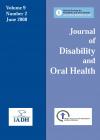Journal of Disability and Oral Health

- Cover Date:
- June 2008
- Print ISSN:
- 1470-8558
- Electronic ISSN:
- 1754-2758
- Vol:
- 9
- Issue:
- 2
Conscious sedationthe only tool in the box?
In 1990, the Standing Dental Advisory Committee published its influential report, known as the Poswillo Report, on General Anaesthesia, Sedation and Resuscitation in Dentistry, to reduce the risk of fatalities and adverse events within primary care facilities (Poswillo, 1990). The report’s recommendations, and subsequently published guidelines (General Dental Council, 1998), aimed at placing general anaesthesia (GA) for dental procedures within a safer framework. In consequence, the treatment option of choice for dental anxiety and phobia that did not respond to basic behavioural management techniques, is conscious sedation. This paper looks at some underlying assumptions made about the management of dental phobia and the ramifications of this modality as being the preferred method employed with anxious patients. The prevalence of dental anxiety Dental anxiety is a common problem. The Adult Dental Health Survey: Oral Health in the United Kingdom 1998, showed that 55% of dentate women and 43% of dentate men reported always feeling anxious about going to the dentist (Kelly et al., 2000). Furthermore, 10% of people avoid dental treatment due to anxiety or fear (Todd and Lader, 1991). Severe dental anxiety is categorised as a specific (isolated) phobia of the Blood-Injection-Injury or Situational Type (American Psychiatric Association, 1994; World Health Authority, 2007). It is a marked and persistent fear, recognised by the patient as excessive or unreasonable, cued by the presence or anticipation of a specific object or situation. Though the triggering situation is discrete, exposure to the stimulus provokes an anxiety response, and it is avoided or endured only with immense anxiety or distress. The anticipation, avoidance, or distress interferes with the patient’s normal routines, occupational functioning, social activities or relationships (American Psychiatric Association, 1994).
- Article Price
- £15.00
- Institution Article Price
- £15.00
- Page Start
- 97
- Page End
- 94
- Authors
- Stephen M Woolley
Articles from this issue
- Title
- Pg. Start
- Pg. End
- Electromyographic evaluation of anterior temporalis and masseter muscles in patients with cerebral palsy before and after postural stabilisation
- 59
- 62
- Oral health status of teenagers and young adults with intellectual impairment in Athens, Greece
- 63
- 69
- An investigation of the association between gingival bleeding and consultations for cardiac, ENT and immunological problems in people with Down syndrome
- 73
- 80
- Preparedness of dental undergraduates for provision of care to individuals with special health care needs in Nigeria
- 81
- 86
